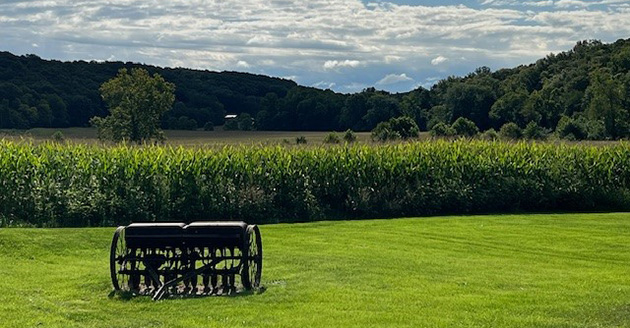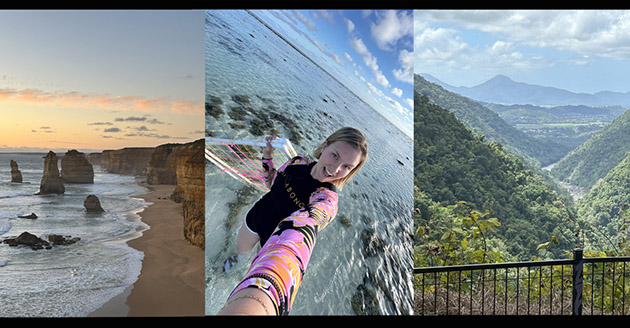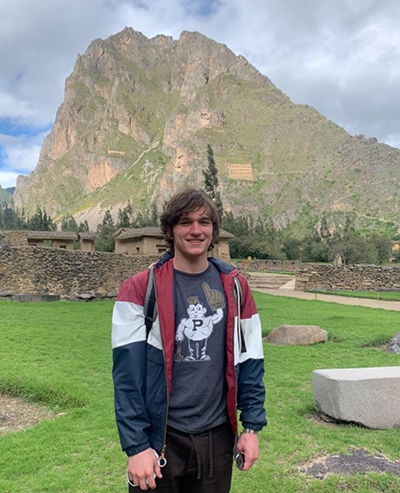 "Wherever you go becomes a part of you somehow." - Anita Desai.
"Wherever you go becomes a part of you somehow." - Anita Desai.
With an interest in discovery and the desire to explore as well as experience with the Spanish language from high school studies, freshman aquatic sciences major Jack Dempsey knew he wanted to study abroad during his college career. When he was presented with the option of a spring break trip to Peru during one of his classes his first semester at Purdue, he jumped at the chance.
The study abroad trip and related course “International Engagement and Community Development in Peru” was led by Drs. Jeneen Fields, clinical assistant professor of botany and plant pathology, and Mark Russell, department head and professor of agricultural sciences education and communication. It aimed to teach students intercultural communication, market analysis, project design and planning, business planning and business ventures, and cultural factors affecting community food security through exposure to established international partners and collaborative work with Peruvian students.
“I knew I wanted to study abroad as soon as possible and I also wanted to go to South America,” Dempsey recalls. “When they presented the trip, they talked about very general global and intercultural stuff. I went in thinking it was going to be a bunch of Ag students and I was probably not going to be much help, but students from a variety of majors went on the trip. The professors stressed that it's as much about personal growth as it is about international engagement and helping the small businesses that we were working with. I found that you don't have to have specific agricultural skills to be helpful there, as long as you have a basic understanding of team synergy.”
Students took an eight-week prep course before leaving on the trip to Peru on March 12 and met for eight more weeks following the trip for response and reflection. Upon reflection, Dempsey noted that the trip not only had immediate impacts such as open mindedness, but also that he has adopted some of the cultural lessons he learned.
“Study abroad is definitely going to have a long-term impact on me, but I'd say the most valuable things I came away with in terms of my career, my schooling, just my life in general, are better communication skills,” Dempsey said. “I definitely improved my teamwork skills a lot and my communication in a team is a lot better now. Even though I knew a decent amount of Spanish, there was still a language barrier. I enjoyed talking to people there, but communication and communication in a team are two very valuable things I learned.
“I'm generally less frustrated about things that I would have gotten frustrated with before, like lack of communication, and it's much harder for me to get overwhelmed. I’d say I'm less stressed about things. I look at people who are from a different culture completely differently, because I, even though it was just for a week, was that person who was from a different culture. Instead of trying to think we're all the same, I think this person is different and that's interesting. Instead of this person is a human just like me, it's more like this person is different in an interesting way and that's cool. This also helped me be myself a lot faster around people, because I was with them for a whole week in this country that was not where I'm from.”
After arriving at the Lima International Airport and taking a bus to Selina Posada in Miraflores, the Purdue students met their counterparts from Universite de La Molina.
On Sunday, the group travelled to the Vacas Felices Farm, which raises cattle and makes dairy products, and visited other businesses in the Allas community.
“It is a very small town, a terraced village on the side of this mountain,” Dempsey said. “It is very interesting, in the village everything is very organic. They grow things not in designated fields, but you walk past a house and there are a bunch of kale plants growing up on a hillside. I’ve never been one for kale, but that was one of the best vegetables I’ve ever tasted just coming out of the ground. They conserve the soil and use it as efficiently as possible. They give the soil five years to recover from a crop when they are done using it.”
In addition to visiting the family run Vacas Felices Farm, the group was treated to a trout lunch in the village before returning to Selina Posada. A dinner with their tour guide Ernesto and an exploration of nearby Kennedy Park awaited that evening.
Dempsey described the day in his journal: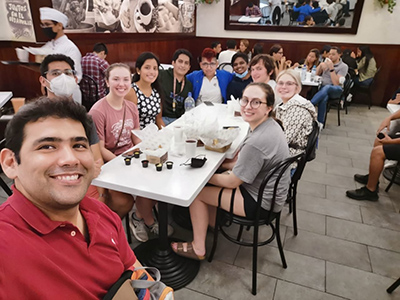
“Going to the highlands for the first time didn’t seem real. It was very surreal because the clouds were right there and the mountains were unlike any mountain I had seen before, like they were ripped out of the ground. In the Allas community, it started raining after our van got stuck, and they served us trout lunch in the town. The lady there told us a story about her pancreatitis, and then she organized a thing where we sat around in groups and discussed various aspects of our life like health, family and whatnot. This was all on the spot because there wasn’t much else to do because of the rain, but it was a nice bonding experience for the group.”
Monday brought a visit to La Universidad Nacional Agraria La Molina, including a presentation on international engagement methods and a tour of the research and teaching facilities on site.
“It was really exciting to see the university,” Dempsey said. “You could tell it was a university but it had different architecture. There was a farm there and there were stables right next to lecture buildings. We got to see hundreds of sheep and alpacas and llamas. They are doing so much research there. Every animal there is being used for research purposes and there are hundreds and hundreds of animals there.”
On Tuesday, the group flew from Lima to Cusco.
“I really loved seeing Cusco for the first time,” Dempsey recalled. “It stood out to me because Cusco is a very, very vibrant city, but none of the buildings are higher than three maybe four stories max, but you can tell it’s a huge city. Later on, we got almost a bird's eye view of Cusco when we went up to a fortress that was overlooking Cusco and all the Incan fortresses. You look one way down this valley of mountains and it stretches on into the fog and then you look the other way and it crawls up mountains and goes all the way around. You can't really see the ends of the city from like 1000 feet up and then it sprawls up mountains on in all directions. That was really striking.”
From Cusco, the class made its way to Ollantaytambo, its home base for the next two days. After lunch, students visited the Ollanytaytambo Fortress.
“We got our first taste of Incan architecture there, where they cut the stones to perfectly fit into one another as opposed to using mortar, so it was earthquake proof, like the sturdiest buildings ever,” Dempsey noted. “These huge stones were cut perfectly. You couldn't fit a piece of paper between any two stones and some of the stones had 25 corners, or something like that. I think there's even one with 50 that's very prized. It was really cool architecture.”
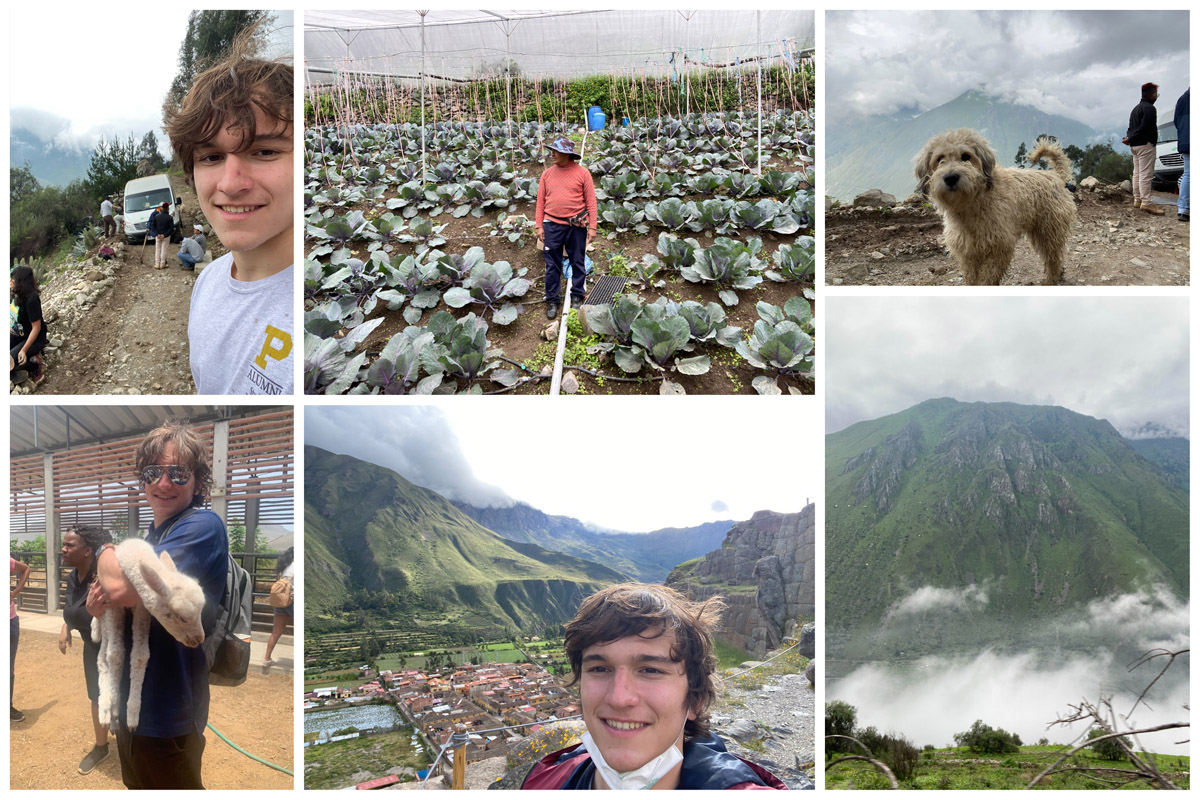
On Wednesday, after a train ride to the city of Aguas Calientes, the group travelled to Machu Picchu, an ancient Incan city located in the Andes Mountains.
“From the top, you get the standard postcard view but then we went in,” Dempsey said. “Our tour guide took us down into the city and he kept telling us you will not see the same thing twice so make sure to ask questions. It was such a big city. I did not know this before, but Machu Picchu is actually in a huge valley. Machu Picchu is 13,000 feet up, but it's in this giant bowl of mountains and there's this one giant mountain in the center and there's terraces all the way at the top of the mountain. They sent engineers to the top of that mountain in this sacred valley to scope out the perfect place to put Machu Picchu and they figured it would be this crest that comes up in the middle of the valley. What you see in pictures is only about 40% of the construction, because they actually built terraces that you can't even see anymore, it's overgrown or eroded. But they built terraces all the way down the mountain, so that the city can’t erode. They basically covered a mountain in construction. There are temples, school houses, and astrology centers there.
“One thing that really interested me was this huge boulder with two bowls carved into it that makes up a floor of this building. They carved the whole thing down just to make these two very shallow bowls and they're full of rainwater and they use those for astrology. They used them like mirrors so they could calculate angles of the stars in the sky and there's two of them because they knew that with the rotation of the earth, the stars would be in a different place at different times of the year. I just thought that was super interesting.”
On the train ride home, the group bonded through conversation and even song. Dempsey’s journal documented it as such:
Machu Picchu was incredible, and I learned so many interesting things about the city. On the train ride back, I was woken up by Jenna (one of my classmates) and Diego (one of the university students there) and we went to the observation car, talked for a while, and caught leaves from trees passing by. Eventually a lot of our classmates joined us, and at some point, someone started singing the song that was playing and we all sang the chorus (it was Perfect by Ed Sheeran) so that was a great experience too. Even our professor Dr. Fields was there and joined in.

Thursday brought the group to Parque de la Papa, or potato park, where students met members of the Pampallacta, Chawaytire and Sacaca communities. Potatoes are indigenous to Peru, with nearly 4000 varieties growing in the country.
“That was very fun; it was probably the highest up we went, probably 13,500 feet to 14,000 feet,” Dempsey said. “It was this huge valley, much bigger than Machu Picchu, and it was covered in many different communities. The chiefs of these communities toured us around. They grow either 1500 or 2000 different kinds of potatoes in this valley. One of the chiefs took us in this room where he had hundreds of different kinds of potatoes, he showed us and talked about each one what it does and like. There's a potato that if you eat it if you have a certain type of cancer, it won't cure your cancer, but it'll give you a better life, whatever you have left. There was another interesting one, this really knobby potato that looked very weird. It gave you an insight into the culture, because a man will pick out a potato and then he'll go over to a woman's house and if he wants to marry her he'll present her with this potato and see how well she can peel it. It's a very, very weird potato, so you have to dig the knife in and out like so. It's basically a test of like how committed are you, how much do you want to marry me. And then the woman will come over to the man's house and they will basically quiz the man on farming to see how well he can farm, have him show them how well he can use farm tools and ask him questions about how he farms. That was a cool insight into the culture.”
A visit to Saqsayhuaman fortress, which overlooks Cusco, awaited on Friday. There students learned about the Incas and their beliefs and culture.
“They really believed in the sanctity of the number three,” Dempsey recalled. “They had three commandments: don't steal, don't lie and don't be lazy. Because they didn't have currency, they just had work and food, so if you were lazy you were saying I don't want to participate in society, I don't deserve food. If you steal then that's really bad because people get the food that they deserve, and I guess lying it's just a standard one. They also had three sacred animals: the snake, the puma and the condor and they represent different parts of the world and also represent different parts of your body and your soul.
“The fortress we visited had three huge layers to it, and at the top, there were three buildings and then one of the buildings had three stories to it that they built up and three layers of circular foundation. This fortress was incredible because it was made of gigantic stones that were brought from a quarry you can see on a distant mountain. They brought the stones all the way there. There was a quarry 100 feet from this fortress and a big boulder of limestone, but they did not use it, because they believed in some sort of sanctity of this boulder. They believed in natural beauty adding to the environment so they went to the other mountain to get limestone. These huge boulders were also carved to fit into each other and they were twice as tall as you. It was very exciting, because once you got to the top you could overlook all of Cusco from the top of this fortress.
“Thousands of people would come to this fortress; it was basically like the Incan Mecca. It was where they performed these big ceremonies to praise the sun. One of the tour guides corrected the notion that they were polytheistic, worshiping the sun and earth. He said they don't worship the sun and the earth or any of these different elements. They present offerings, the best of the crop or the best of whatever they have, the best textiles, etc. He compared it to if you give your father a gift on his birthday, are you worshiping him? No, you're appreciating him for what he's done for you, so that was their thing, they're appreciating the earth by giving back some of the best stuff it gave them. That was cool.”
The group flew back to Lima on Friday afternoon. On Saturday, they visited a local market alongside a chef, and bought fruits, vegetables and meats, which they utilized in an interactive cooking experience at an urban kitchen.
“We participated in the cooking class and we had lunch there too,” Dempsey recalled. “It was the best meat that I had ever had; it was perfect. It's not every day you get to have a meal cooked by like a super good chef, and this was really, really good.”
Later Saturday, a visit to Larco Herrera Museum allowed students to see thousands of Incan artifacts, while a visit to the Vacas Felices retail store in Lima allowed students to learn more about the operations of the cattle/dairy farm they visited on their first day of the trip.
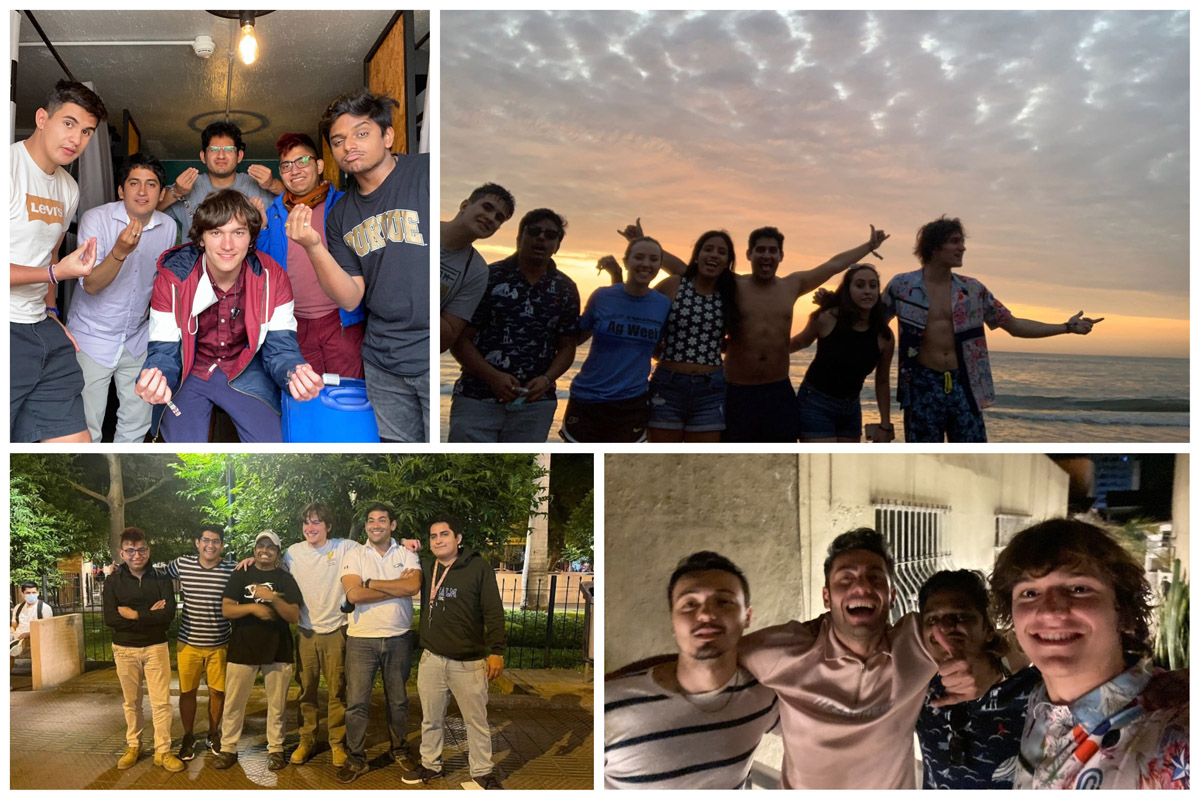
After a jam-packed trip of experiences, Dempsey tried to narrow down the trip highlights.
“My top three: the friends I was there with, the tour guides and university students, and Machu Picchu,” Dempsey said. “I made some really good friendships there and experiencing all of it with the friends I made there was a very cool experience. I immediately made friends with people, and then we got really close throughout the week. Just seeing everything with them, roaming around cities, and walking through Cusco or Lima or Ollantaytambo and having fun … a highlight of my trip was the people I was there with.
“I'd also have to say Machu Picchu, that was very cool, of course, the first Wonder of the World I have ever seen. Also, it was cool talking to Ernesto and the other tour guides we were with and the university students from the University of La Molina that accompanied us the whole time. They were the only people that I had got to have long form conversations with. I spent a lot of time hanging out with Diego, one of the students. We had a group of people we hung out with and there were so many notable moments that were so interesting to me about a different culture. He knew English so I was just talking to him and messing around, but now that I'm thinking about it, there were much more than just a few moments where I noticed our culture was different. It was very much a whole different way of thinking.”
His experience in Peru has Dempsey thinking about a future study abroad trip, whether that be a Maymester or full semester abroad later in his academic career. In the meantime, the Washington D.C. area native is focused on his aquatic sciences major, with an emphasis in marine biology.
“I've been thinking about research and marine biology since my senior year of high school,” Dempsey said. “I really enjoyed my marine biology class last semester. I really like exploration and discovery, so that's why I'm really drawn to the ocean. I've been going to the ocean ever since I was a baby. I really love the ocean and how vast and unexplored it is. So, if I can do any sort of exploration or research in the ocean, as much field work as I can get, that would be fun for me. I envision myself living on a coast doing research.”

